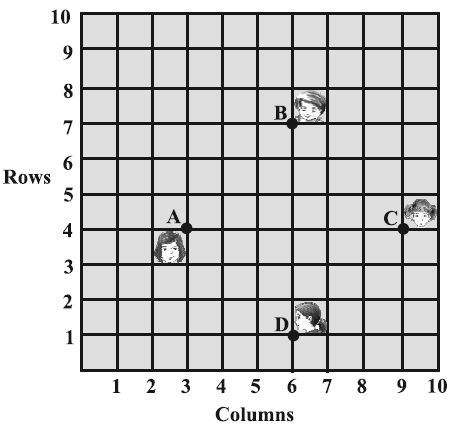FINDING DISTANCE BETWEEN TWO POINTS EXAMPLES
Let (x1, y1) and (x2, y2) be the two points as shown below.

Then, the formula for the distance between the two points is
√[(x2 - x1)2 + (y2 - y1)2]
Examples
Example 1 :
Check whether (5,-2) (6,4) and (7,-2) are the vertices of an isosceles triangle.
Solution :
Let the given points as A(5,-2) B(6,4) and C(7,-2)
Distance between two points = √(x2 - x1)2 + (y2 - y1)2
Length of the side AB :
Here, x1 = 5, y1 = -2, x2 = 6 and y₂ = 4
= √(6 - 5)2 + (4 - (-2))2
= √12 + (4+2)2
= √1 + 36
= √37
Length of the side BC :
Here, x1 = 6, y1 = 4, x2 = 7 and y₂ = -2
= √(7 - 6)2 + (-2 - 4)2
= √12 + (-6)2
= √1 + 36
= √37
Length of the side CA :
Here, x1 = 7, y1 = -2, x2 = 5 and y₂ = -2
= √(-5 - 7)2 + (-2 - (-2))2
= √(-12)2 + (-2 + 2)2
= √144 + 0
= √144
= 12
AB = BC
Since length of two sides are equal, the given points are the vertices of a triangle.
Example 2 :
In a classroom 4 friends are seated at the points A,B,C and D as shown in figure given below. Champa and Chameli walk into the class and after observing for a few minutes champa asks Chameli,"Don't you think ABCD is a square?" Chameli disagrees. Using distance formula, find which of them is correct.

Solution :
It can be observed that A (3, 4) , B (6, 7), C(9, 4) and D(6, 1) are the position of these 4 friends.
Length of AB :
Here, x1 = 3, y1 = 4, x2 = 6 and y2 = 7
= √(6 - 3)2 + (7 - 4)2
= √(3)2 + (3)2
= √9 + 9
= √18
= 3√2
Length of BC :
Here, x1 = 6, y1 = 7, x2 = 9 and y2 = 4
= √(9 - 6)2 + (4 - 7)2
= √(3)² + (-3)²
= √(9 + 9)
= √18
= 3√2
Length of CD :
Here, x1 = 9, y1 = 4, x2 = 6 and y2 = 1
= √(6 - 9)² + (1 - 4)²
= √(-3)² + (-3)²
= √9 + 9
= √18
= 3√2
Length of DA :
Here, x1 = 6, y1 = 1, x2 = 3 and y2 = 4
= √(3 - 6)² + (4 - 1)²
= √(-3)² + (3)²
= √9 + 9
= √18
= 3√2
Length of diagonal AC :
Here, x1 = 3, y1 = 4, x2 = 9 and y2 = 4
= √(9 - 3)2 + (4 - 4)2
= √62 + 02
= √36
= 6
Length of diagonal BD :
Here, x1 = 6, y1 = 7, x2 = 6 and y2 = 1
= √(6 - 6)2 + (1 - 7)2
= √02 + (-6)2
= √36
= 6
It can be observed that all the sides of this quadrilateral ABCD are the same length and also the diagonals are of the same length.
Therefore, ABCD is a square. Hence, Champa was correct.
Kindly mail your feedback to v4formath@gmail.com
We always appreciate your feedback.
©All rights reserved. onlinemath4all.com
Recent Articles
-
Derivative Problems and Solutions (Part - 1)
Jul 16, 24 11:19 AM
Derivative Problems and Solutions (Part - 1) -
Derivative Problems and Solutions (Part - 2)
Jul 16, 24 11:17 AM
Derivative Problems and Solutions (Part - 2) -
Cbse 10th Maths Ncert Solutions Pdf
Jul 16, 24 07:14 AM
CBSE 10th Maths Ncert Solutions Pdf